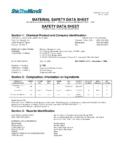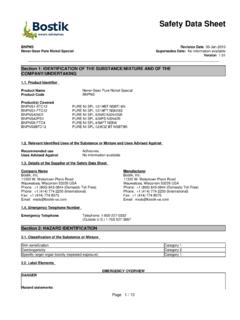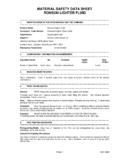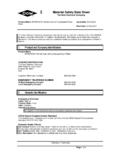Transcription of MATERIAL SAFETY DATA SHEET - pandclab.com
1 MATERIAL SAFETY data SHEET1. Product and Company IdentificationMaterial nameThinPrep PreservCyt SolutionVersion #003 Issue date09-August-2013 Revision date-Supersedes date-CAS #MixtureMSDS Number85093-001 Rev. 003 Product useA methanol based, buffered preservative solution used to support cells during transport and informationManufacturerHologic Campus DriveMarlborough, Massachusetts, 01752 USAT elephone(800) 442-9892 ContactEmergency Telephone3E Hotline: 1-866-519-4752 Access Code: Hazards IdentificationPhysical , colorless overviewDANGERF lammable liquid and vapor. May be fatal if swallowed. Harmful if inhaled or absorbed throughskin.
2 Causes skin and eye irritation. May cause central nervous system health effectsRoutes of exposureIngestion. Inhalation. Skin contact. Eye eye skin irritation. Harmful if absorbed through if inhaled. May cause central nervous system be fatal if swallowed. Even small amounts (30-250 ml methanol) may be fatal. Symptoms arestomach ache, nausea, vomiting, dullness, visual disorder and organsCentral nervous system. Eyes. Respiratory system. effectsMethanol: Human exposure to methanol may result in illness, systemic poisoning, blindness, opticnerve damage and perhaps death, after being ingested, absorbed through the skin or due to cardiac or respiratory failure has been reported in some cases from consumption ofas little as 30 and symptomsProlonged and repeated exposure to high vapor concentrations, skin absorption or ingestion ofmethanol may result in visual disturbances, metabolic acidosis, headache, giddiness, nausea,insomnia, gastric disturbance, dizziness, and slow breathing.
3 There have been severe casesreported of blindness, coma and death due to the ingestion of #Percent3. Composition / Information on Ingredients7732-18-540 - 70 Water67-56-130 - 60 MethanolComposition commentsAll concentrations are in percent by weight unless ingredient is a gas. Gas concentrations are inpercent by PreservCyt SolutionCPH MSDS NA909897 Version #: 003 Revision date: - Issue date: 09-August-20131 / 84. First Aid MeasuresFirst aid proceduresEye contactImmediately flush with plenty of water for up to 15 minutes. Remove any contact lenses and openeyelids wide apart. If irritation persists: Continue flushing during transport to hospital.
4 Take alongthese contactTake off immediately all contaminated clothing. Immediately flush thoroughly with water for at least15 minutes. Get medical attention immediately. Wash contaminated clothing before victim to fresh air and keep at rest in a position comfortable for breathing. If breathing isdifficult, give oxygen. Do not use mouth-to-mouth method if victim inhaled the substance. Induceartificial respiration with the aid of a pocket mask equipped with a one-way valve or other properrespiratory medical device. Get medical attention not induce vomiting without advice from medical personnel. Drink 1 or 2 glasses of give anything by mouth to an unconscious person.
5 Get medical attention to physicianTreat for CNS depression and possible renal failure. Provide general supportive measures andtreat symptomatically. Symptoms may be delayed. Ethanol and fomepizole are effective antidotesfor methanol poisoning, although fomepizole is adviceEnsure that medical personnel are aware of the MATERIAL (s) involved, and take precautions toprotect Fire Fighting MeasuresFlammable propertiesFlammable liquid and vapor. By heating and fire, toxic vapors/gases may be formed. Heat maycause the containers to mediaSuitable extinguishingmediaDry chemical, foam, carbon dioxide. Water may be an ineffective extinguishing extinguishingmediaDo not use a solid water stream as it may scatter and spread of firefightersSpecific hazards arisingfrom the chemicalHeating will generate vapors which may form explosive vapor/air equipment andprecautions for firefightersSelection of respiratory protection for firefighting: follow the general fire precautions indicated inthe workplace.
6 As in any fire, wear self-contained breathing apparatus pressure-demand,MSHA/NIOSH (approved or equivalent) and full protective fightingequipment/instructionsEvacuate area. Move containers from fire area if you can do it without risk. Prevent runoff from firecontrol or dilution from entering streams, sewers, or drinking water supply. Use standardfirefighting procedures and consider the hazards of other involved materials. Use water spray tocool unopened methodsKeep unnecessary personnel away. Use standard firefighting procedures and consider thehazards of other involved combustionproductsCarbon monoxide.
7 Carbon Accidental Release MeasuresPersonal precautionsEnsure adequate ventilation. Eliminate all ignition sources (no smoking, flares, sparks or flames inimmediate area). Wear suitable protective clothing, gloves and eye/face protection. Wearprotective clothing as described in Section 8 of this SAFETY data SHEET . Follow standard precautionsPrevent further leakage or spillage if safe to do so. Avoid discharge to the aquatic for containmentELIMINATE all ignition sources (no smoking, flares, sparks or flames in immediate area). Stop theflow of MATERIAL , if this is without risk. Dike the spilled MATERIAL , where this is possible.
8 Collectspillage. Prevent entry into waterways, sewer, basements or confined for cleaning upImmediately contact emergency personnel. Remove sources of ignition. Beware of the explosiondanger. Absorb spillage with non-combustible, absorbent MATERIAL . Clean surface thoroughly toremove residual contamination. Never return spills in original containers for informationClean up in accordance with all applicable PreservCyt SolutionCPH MSDS NA909897 Version #: 003 Revision date: - Issue date: 09-August-20132 / 87. Handling and StorageHandlingUse only with adequate ventilation. Wear appropriate personal protective equipment.
9 Observegood industrial hygiene practices. Avoid contact with eyes, skin, and clothing. Avoid inhalation ofvapors. The product is highly flammable, and explosive vapor/air mixtures may be formed even atnormal room temperatures. Ground container and transfer equipment to eliminate static electricsparks. Use non-sparking hand tools and explosion-proof electrical equipment. Vapors are heavierthan air and may travel along the floor and in the bottom of containers. Avoid release to rules for flammable liquids. Keep away from heat, spark, open flames and other sources ofignition. Keep container tightly closed in a cool, well-ventilated place.
10 Store away fromincompatible materials. Keep out of the reach of temperature:Without cytologic sample: 59-86 F (15-30 C)With cytologic samples, for up to six weeks: 39-99 F (4-37 C)8. Exposure Controls / Personal ProtectionOccupational exposure limitsUS. ACGIH Threshold Limit ValuesValueTypeComponentsSTEL250 ppmMethanol (CAS 67-56-1)TWA200 ppmUS. OSHA Table Z-1 Limits for Air Contaminants (29 CFR )ValueTypeComponentsPEL260 mg/m3 Methanol (CAS 67-56-1)200 ppmCanada. Alberta OELs (Occupational Health & SAFETY Code, Schedule 1, Table 2)ValueTypeComponentsSTEL328 mg/m3 Methanol (CAS 67-56-1)250 ppmTWA262 mg/m3200 ppmCanada.








